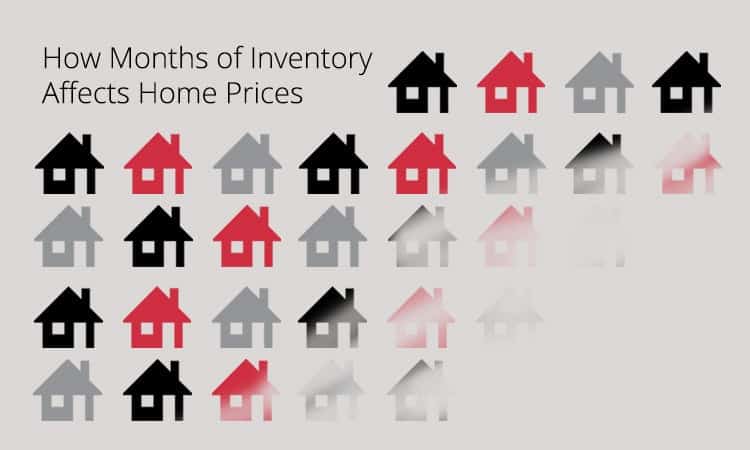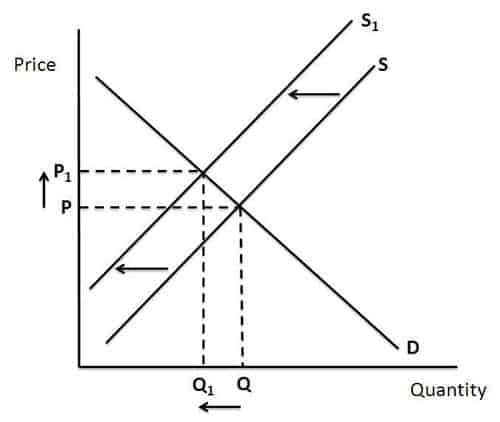Last Updated on May 24, 2023

If you’re new to the exciting and fast-paced world of home shopping, it can feel overwhelming to navigate all the options available to you—let alone all the real estate industry jargon. But as unapproachable as it may sound, your agent is choosing his or her words very carefully. Each seemingly mundane real estate term translates to market metrics that can make or break your home purchase.
Today, we’re going to look at Months of Inventory and how it affects your ability to purchase a home.
What is months of inventory?
Months of Inventory (MOI) is the relationship of sales pace to the number of properties currently on the market if no additional homes were added to the supply. It is calculated by determining the number of homes sold per month and dividing by the total number of properties for sale on the last day of the month. It is susceptible to changes in supply and/or sales pace.
Homes Sold Month X = Months of Inventory
Available Properties for Sale
In layman’s terms, Months of Inventory gives you a relative understanding of how many homes are for sale in your area. Looking at the equation above, we can see that if a lot of homes sell, the MOI goes down. Similarly, if sales are stable from month to month, but few new homes hit the market, the number of available properties for sale will decrease, again affecting the MOI.
How does months of inventory affect home prices?
Think back to your 9AM business class in high school. Do you remember talking about the laws of supply and demand? They were always graphed like a giant X. And one arm of the X was always moving.
There’s a tenuous balance between the quantity of any given commodity and its average market price. The demand for the product can affect its quantity (or vice versa), which in turn affects the price. When supply dips (or shifts left in the graph), the people with the supply can get away with charging more, because buyers are willing to pay more.

The same concept can affect local, regional, and even national real estate markets. Right now in Western North Carolina, counties are seeing significant decreases in homes for sale compared to this time last year. Three counties covered by Allen Tate/Beverly-Hanks (Haywood, Madison, Transylvania) are seeing decreases of 20% or more! This has shifted sales in many areas to a seller’s market, especially in the lower price brackets where inventory is lowest.
What does a seller’s market mean for home purchases?
In a real estate transaction, the party with the upper hand is often the one who has the market inventory on their side. When there is more than six months of inventory on the market, there is ample supply for buyers to choose from, so we say it is a buyer’s market. If there is less than six months of inventory, buyers have to compete more for each home, so sellers don’t have to give in to buyer demands as readily. We say this is a seller’s market. At around six months of inventory, we call the market balanced.
Unfortunately, a seller’s market is not the best news for home buyers. There is more demand for less inventory, and it’s hard for buyers to negotiate down a home’s sale price. This can be a difficult market for less experienced home buyers to navigate alone.
However, even in locations like Haywood County, which is seeing a 27% reduction in inventory compared to 2016, there is some hope for buyers. Markets can shift significantly at each price point. A strong seller’s market below $199,000 can give way to an easy buyer’s market at the $300,000 threshold. If you are able to adjust your price point or can consider locations farther from city centers, you’re still able to buy smart in the current competitive market.
Learn more on our Market Research Center
Months of Inventory is just one of many real estate terms that will help you better understand local and national real estate markets. Learn more key real estate market terms, then visit our Market Research Center. View the market activity for your community and read the online PDF of our latest Allen Tate/Beverly-Hanks Quarterly Market Report. Take note: On each county’s Vital Signs page, we list the MOI for each price bracket. We also note whether the market favors buyers or sellers, or is balanced.
All real estate is local. In order to make confident real estate decisions, we believe it is important for you to have timely and neighborhood-specific information. If you would like more information about your local market activity, our experts at Allen Tate/Beverly-Hanks are here to help. Contact us today to speak with an Allen Tate/Beverly-Hanks real estate agent about buying homes and land in Western North Carolina.



